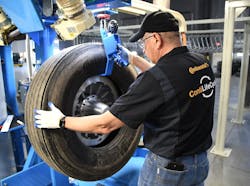“A manufacturer cannot provide for the needs of fleets without a solid distribution network and cannot develop a solid distribution network without fleet business to support it,” says John Barnes, head of Continental’s ContiLifeCycle retreading for the Americas region.
Continental continues to build out its BestDrive network, which includes a 100,000-square-foot retread “mega-plant’ near Dallas, Texas, as well as its ContiLifeCycle network of independent retreaders. In this interview, Barnes discusses how Continental balances the interests of both, the ongoing ramp-up of its tread rubber plant in Mount Vernon, Ill., and more.
MTD: What’s your take on the current state of the retread market as we prepare to enter the second quarter of the year?
Barnes: The market appears to be relatively flat, gaining in some areas while losing in others. There are no red flags or indications of a downturn. While we have some amount of optimism, we do not see any major growth for the North American retread market so far in 2020.
MTD: What trends did you observe during the first quarter of 2020 and how did they impact Continental’s retread business?
Barnes: Continental substantially outperformed the market in North America last year, leading to share of market growth. In the first quarter of 2020, neither the softening of the original equipment market –
nor the tariffs on Chinese goods – has produced any noticeable effect on the retread market.
So far this year, our dealers continue to experience growth, fueled in large part by the continued advance of our fleet solutions and lifecycle approach, which combines new tires, retreads and digital tire monitoring solutions. Continental has a strong portfolio of tire products, as well as digital solutions that monitor and maximize the performance of the tires. Fleets can prove the value we offer and this is a large part of why we continue to exceed the market average.
Retreading is key to the lifecycle approach. Fleets are always interested in maximizing their investment in their new tires by using retreads. Continental’s commitment to matching the development of the best new tires with harmonized retreads – our “looks like new, runs like new” philosophy – delivers value for the complete lifecycle of our products.
MTD: How do you balance the needs and strategy of the Best Drive chain and its retread operations versus the needs and strategies of independently owned and operated ContiLifeCycle retreaders?
Barnes: Our primary focus is to s upply fleets with the services and products they need, where they need them. Whether it is a BestDrive location or an independent ContiLifeCycle retreader, they follow the same audited ContiLifeCycle retread process and commit to delivering the same level of service to our fleet customers. A manufacturer cannot provide for the needs of fleets without a solid distribution network and cannot develop a solid distribution network without fleet business to support it. Continental understands and addresses this from both sides.
MTD: Last May, Continental told MTD that its Mount Vernon, Ill., plant was preparing for a 300% increase in the production of pre-cure tread rubber due to rapidly growing demand. Nearly one year later, has that production ramp-up occurred or is the ramp-up still in process? What is driving demand?
Barnes: The ramp-up in Mount Vernon is on track and in line with driving demand. It is driven by multiple factors, the most significant of which is the growth we see in our retread business. We also transferred production of several popular U.S. retread patterns into Mount Vernon to increase speed to market and reduce transport times.
MTD: What impact – if any – are tariffs and the ongoing trade war with China having on Continental’s retread business in the U.S.?
Barnes: Last year, the import data shows that a significant volume of product was brought in from China before the tariffs went into effect. With the OE slowdown, plant capacities opened up worldwide. So far, the net effect is that there was little shift of demand from third-tier products to retreads. There is optimism that soon we will see demand starting to exceed supply in this segment, driving volume toward the retread industry.
“Regardless, it’s important for fleets to calculate the true cost-per-mile of the tires they are buying,” says Barnes. “Investing in a premium tire designed for retreadability can often deliver a lower cost-per-mile than purchasing multiple lower-cost products. This was true before the tariffs and continues to be relevant.”




